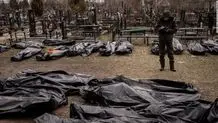Russia deploys up to 20,000 mercenaries in battle for Ukraine’s Donbas region
Moscow is luring mercenaries from Syria, Libya and elsewhere in effort to capture as much as possible of eastern Ukraine.

THE GUARDIAN: Moscow is luring mercenaries from Syria, Libya and elsewhere in effort to capture as much as possible of eastern Ukraine.
Russia has deployed up to 20,000 mercenaries from Syria, Libya and elsewhere in its new offensive in Ukraine’s Donbas region, sent into battle with no heavy equipment or armoured vehicles, according to a European official.
The official said the estimates of mercenary involvement on the ground in eastern Ukraine range from 10,000 to 20,000 and that it was hard to break down that figure between Syrians, Libyans and other fighters recruited by the Russian mercenary company, the Wagner Group.
Syrian ex-soldiers have been offered monthly salaries of between $600 and $3,000, depending on rank and experience, to fight in Ukraine. Wagner is reported to have moved most of its soldiers who had been fighting in Libya to Ukraine, and last month Ukrainian military intelligence claim that Russia had made a deal with the Moscow-backed Libyan warlord Khalifa Haftar to send Libyan fighters.
The mercenaries are being thrown into the Russian attempt to capture as much as possible of eastern Ukraine, in what western defence officials have described as a rush to have some sort of victory that Vladimir Putin can announce at the 9 May military parade in Moscow commemorating the second world war.
The Kremlin is seen as having four objectives in this second phase of its war in Ukraine, the European official said: capturing the Donbas, securing a land bridge to Crimea in which the besieged city of Mariupol is crucial, seizing Kherson oblast to secure the supply of freshwater to Crimea, and capturing additional territory that could be used as a buffer or a bargaining chip in negotiations.
Russia is still thought to have three-quarters of the armed force it began the war with in February: 76 battalion tactical groups, about 60,000 troops in all. Western officials say the Russian army faces many of the same limitations that led to its defeat in the battle for Kyiv and the north.
It has logistical challenges even though the supply lines to the Donbas are shorter, and much will depend on the condition of the roads and railways.
“You need to keep in mind that the Russian army is very dependent on railroads and the train network has been targeted many times by the resistance,” the European official said. Furthermore, morale in the Russian ranks is low and getting lower, the official said.
“They don’t like this war because they don’t like the idea of killing people who speak Russian. They have lost many comrades in the north and they have lost the navy cruiser Moskva.”
Third, the Russians still do not have guaranteed air superiority so cannot provide permanent close air support to their troops on the ground, the official said.
Russian commanders are seeking to crush the last stand by Ukrainian marines in Mariupol to free up troops to push north with the aim of cutting off Ukrainian forces fighting in the Donbas, a senior US defence official told reporters on Tuesday.
The official said, however, there was no inevitability about that happening, pointing out that the Ukrainian military was being replenished on a daily basis with new weaponry.
After talking to allied leaders, Joe Biden announced that the US would be providing Ukraine with long range howitzers, which the US defence official said would arrive “very, very soon”. The official added that seven planeloads of equipment, part of the $800m tranche approved last week, will begin arriving in the next 24 hours. The Pentagon said that Ukraine had also received aircraft recently, but not from the US. Washington has however supplied aircraft spare parts to help get more of Ukraine’s planes in the air.




